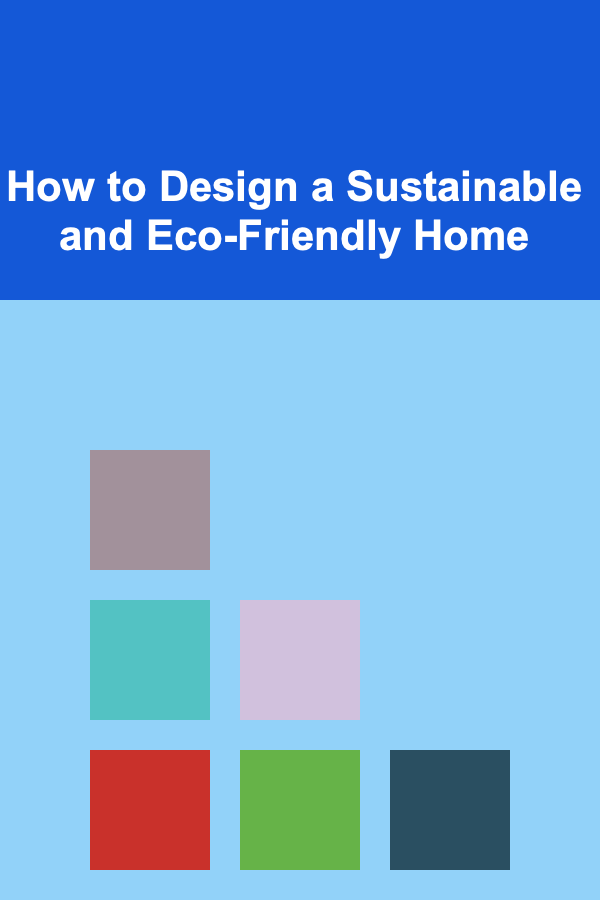
How to Design a Sustainable and Eco-Friendly Home
ebook include PDF & Audio bundle (Micro Guide)
$12.99$11.99
Limited Time Offer! Order within the next:

Designing a sustainable and eco-friendly home is not just about using recycled materials or installing solar panels. It's about creating a space that minimizes environmental impact, optimizes energy efficiency, and promotes the well-being of its inhabitants. As awareness about climate change and environmental degradation increases, more homeowners and architects are turning to sustainable design practices. This long-form article will explore key principles, materials, and strategies for creating a sustainable and eco-friendly home, while also delving into the long-term benefits of such designs.
Understanding Sustainability in Home Design
Before diving into the specifics of eco-friendly home design, it's important to define what sustainability in home construction means. Sustainable home design takes into account the entire lifecycle of the building, from the sourcing of materials to the energy consumption during its operation, as well as its ultimate demolition or repurposing. It aims to reduce the building's environmental footprint and create a healthier environment for its occupants.
Key principles of sustainable design include:
- Energy Efficiency: Reducing the energy consumption of the home through the use of efficient systems and appliances.
- Water Conservation: Implementing solutions to reduce water usage and recycle water where possible.
- Material Sourcing: Using sustainable, non-toxic, and locally sourced materials to reduce waste and environmental impact.
- Indoor Air Quality: Creating a healthier indoor environment with non-toxic paints, proper ventilation, and natural light.
- Waste Reduction: Designing a home with the ability to reuse or recycle materials at the end of its life cycle.
Key Strategies for Designing a Sustainable and Eco-Friendly Home
1. Passive Design: Harnessing Natural Energy
One of the most important strategies for creating an eco-friendly home is the concept of passive design. This involves designing a home to naturally regulate its temperature using elements like sunlight, air circulation, and thermal mass. A well-thought-out passive design can reduce the need for mechanical heating and cooling, which can save homeowners significant energy costs.
Key Elements of Passive Design:
- Orientation: Positioning the home in a way that maximizes natural light and solar gain while minimizing exposure to harsh winds. South-facing windows (in the Northern Hemisphere) can allow sunlight to heat the home in winter, reducing heating costs.
- Insulation: Proper insulation in walls, floors, and ceilings helps maintain a consistent indoor temperature. High-performance insulation minimizes heat loss in winter and keeps the home cool in the summer.
- Thermal Mass: Materials like concrete, brick, or stone that absorb and store heat during the day and release it at night. This helps in regulating temperature fluctuations.
- Shading: Use of overhangs, pergolas, or trees to prevent excessive heat from the sun during the summer months while allowing sunlight in during the winter when the sun's angle is lower.
2. Energy-Efficient Appliances and Systems
Energy-efficient appliances and systems are at the heart of a sustainable home. These not only reduce the home's energy consumption but also lower utility bills in the long run. Here are a few strategies for enhancing energy efficiency:
High-Efficiency HVAC Systems
Heating, ventilation, and air conditioning (HVAC) systems are typically among the largest energy consumers in a home. Modern energy-efficient HVAC systems, such as heat pumps and geothermal systems, can reduce energy usage by as much as 50%. Additionally, programmable thermostats and zoning systems allow for precise control of heating and cooling, ensuring energy is only used when and where needed.
Energy-Efficient Lighting
Switching to LED lights instead of traditional incandescent or fluorescent bulbs can dramatically reduce electricity consumption. LED bulbs use up to 75% less energy and last 25 times longer, which translates into lower energy costs and fewer replacements over time.
Efficient Appliances
When selecting appliances for a sustainable home, opt for those with high Energy Star ratings, as these are the most energy-efficient. Choose dishwashers, refrigerators, washing machines, and dryers that use minimal electricity and water. Induction cooktops, for instance, heat food faster and with less energy than traditional gas or electric stoves.
3. Sustainable Materials
Using sustainable materials not only reduces the environmental footprint of the home but also promotes healthier indoor air quality. The materials used in the construction process have a significant impact on the home's energy consumption, durability, and overall environmental impact.
Recycled and Reclaimed Materials
Recycling and reclaiming materials for use in construction is one of the most effective ways to reduce waste and decrease demand for new resources. For example, reclaimed wood from old barns, warehouses, or factories can be used for flooring, paneling, or furniture. Recycled steel, glass, and plastic are also increasingly being used in home construction.
Low-VOC and Non-Toxic Paints and Finishes
Many conventional paints and finishes contain volatile organic compounds (VOCs), which can release toxic gases into the air and cause health problems. Low-VOC or zero-VOC paints, stains, and sealants are safer for both the environment and the people living in the home.
Bamboo and Cork
Bamboo is a rapidly renewable resource that is used for everything from flooring to furniture. It's incredibly strong and durable while being lighter and faster to grow than traditional hardwood. Similarly, cork, harvested from the bark of cork oak trees, is another renewable material used for flooring, insulation, and furniture.
Local Sourcing
By sourcing materials locally, homeowners can reduce the environmental impact associated with transportation, which is a significant contributor to carbon emissions. Furthermore, locally sourced materials often have a lower cost and better fit for the local climate and environment.
4. Water Conservation and Management
Water conservation is an essential part of sustainable home design. The average person uses around 80 to 100 gallons of water a day, much of which is wasted due to inefficient systems and habits. Designing a home with water conservation in mind helps not only to reduce the home's environmental footprint but also to lower water bills.
Water-Efficient Fixtures
Low-flow faucets, showerheads, and toilets can drastically reduce water consumption without sacrificing comfort. For example, low-flow showerheads use as little as 2.5 gallons per minute (GPM) compared to older models that use up to 5 GPM.
Rainwater Harvesting
Rainwater harvesting systems capture rainwater from the roof and store it in barrels or tanks for later use. This water can be used for irrigation, flushing toilets, or even washing clothes. Installing a rainwater harvesting system can significantly reduce the amount of potable water required for non-drinking purposes.
Greywater Recycling
Greywater is the relatively clean wastewater from baths, showers, sinks, and washing machines. With proper filtration, greywater can be reused for irrigation or flushing toilets, reducing the demand for fresh water.
5. Renewable Energy Sources
One of the most impactful ways to make a home eco-friendly is by generating energy through renewable sources. Solar, wind, and geothermal systems can significantly reduce reliance on fossil fuels and lower energy bills.
Solar Power
Solar panels are among the most common and effective ways to generate renewable energy at home. By installing photovoltaic (PV) panels on the roof, homeowners can capture sunlight and convert it into electricity. Over time, the initial investment in solar panels often pays off in the form of lower energy bills and even tax incentives.
Wind Power
For homes located in areas with sufficient wind resources, small residential wind turbines can be an excellent way to produce clean energy. These systems can complement solar panels or act as a primary energy source in suitable locations.
Geothermal Heating and Cooling
Geothermal energy systems use the stable temperature of the earth to heat and cool a home. By installing a geothermal heat pump, homeowners can reduce their reliance on conventional heating and cooling systems while reducing their energy consumption and carbon footprint.
6. Indoor Air Quality and Ventilation
Indoor air quality is often overlooked in traditional home designs, but it plays a crucial role in health and well-being. Poor indoor air quality can lead to respiratory problems, allergies, and overall discomfort. A sustainable home design focuses on promoting healthy indoor air through proper ventilation and the use of non-toxic materials.
Mechanical Ventilation
While passive ventilation through windows and vents is effective in mild climates, many modern homes benefit from mechanical ventilation systems, such as heat recovery ventilators (HRVs) or energy recovery ventilators (ERVs). These systems bring in fresh air while exhausting stale air, ensuring proper airflow and preventing the buildup of moisture and pollutants inside the home.
Natural Light
Natural light is essential for both the health of the inhabitants and the energy efficiency of the home. Strategically placed windows, skylights, and light tubes allow for maximum daylight penetration, reducing the need for artificial lighting during the day.
Non-Toxic Building Materials
As mentioned earlier, the use of low-VOC paints, finishes, and adhesives can significantly improve indoor air quality. Additionally, choosing natural materials like wood, stone, and clay over synthetic alternatives reduces the number of potentially harmful chemicals released into the indoor environment.
Conclusion
Designing a sustainable and eco-friendly home is a thoughtful process that goes beyond aesthetics. It requires a comprehensive approach that includes energy efficiency, water conservation, material sourcing, and indoor air quality. The long-term benefits of sustainable design are immense, from reducing environmental impact to providing healthier living spaces for inhabitants. Whether you are building a new home or retrofitting an existing one, adopting eco-friendly practices will not only contribute to a greener planet but also save money and resources over time. As we continue to face global environmental challenges, sustainable home design is an essential step toward a more sustainable future.

How to Clean Your Home After a Home Improvement Project
Read More
How to Create a Festive Atmosphere with Holiday Lighting
Read More
How to Decorate for the Holidays with Items You Already Have
Read More
How to Store Sports Equipment in a Compact Space
Read More
How to Tackle Kitchen Deep Cleaning in Simple Steps
Read More
How to Use AI for Medical Imaging Analysis
Read MoreOther Products

How to Clean Your Home After a Home Improvement Project
Read More
How to Create a Festive Atmosphere with Holiday Lighting
Read More
How to Decorate for the Holidays with Items You Already Have
Read More
How to Store Sports Equipment in a Compact Space
Read More
How to Tackle Kitchen Deep Cleaning in Simple Steps
Read More